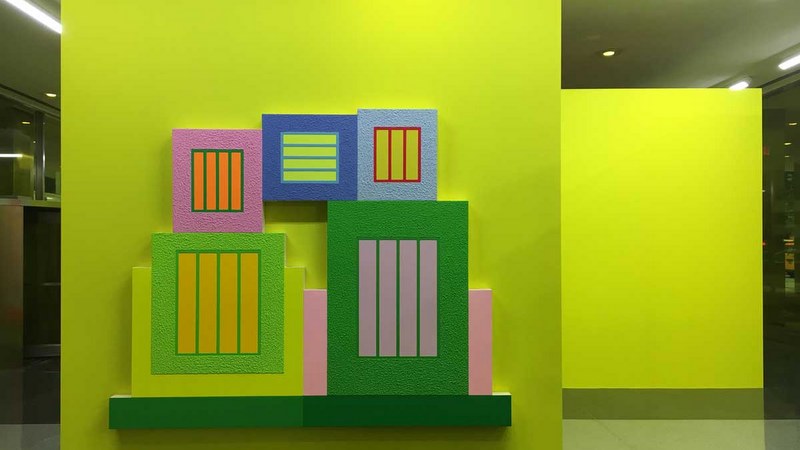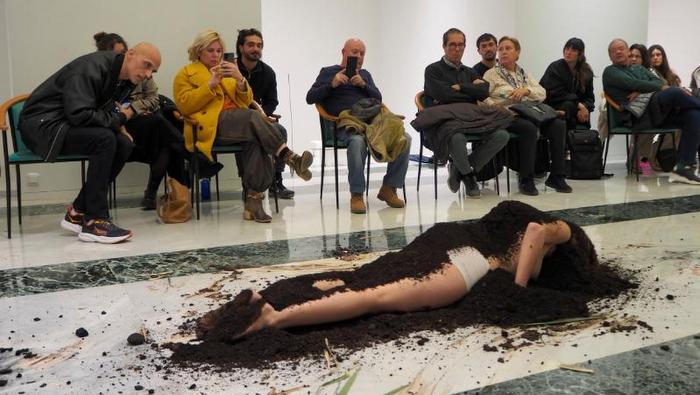Lever House Art Collection is pleased to present New York, New York, a site‐specific commission by New York artist Peter Halley (b. 1953). The large‐scale installation encompasses Lever House’s ground‐floor lobby in addition to the dramatic block‐long band of windows ringing the building’s second floor. The exhibition includes six large shaped‐ canvas paintings as well as a sequence of digitally‐generated mural works hidden within a seemingly impenetrable block‐like central structure.
In this two‐floor immersive installation, Halley uses the circuit‐like compositions of his paintings as inspiration for the lobby’s layout, inviting viewers to feel as if they are walking through the space created by one of his paintings. Yellow window film on the exterior windows and yellow‐tinted ceiling lighting create an artificial, irradiated presence. “The installation is foremost a series of changing scales. The sweeping band of yellow light on the second floor can be seen at night from blocks away. The paintings in the first‐floor lobby address the viewer at street level. When within the lobby, the structure I built to support the paintings has an interior passageway, leading into two hidden rooms, invisible to passersby on the street.”
Eschewing the confinement of his rectilinear abstract paintings, the interior of the central structure is reminiscent of the “low‐budget mysticism” advocated by Robert Smithson — as frequently cited by Halley. Upon entering, the visitor encounters an interior hallway intricately collaged with images from Halley’s notebooks of the 1980s — chronicling the development of Halley’s paintings in the early 80s. Following this, visitors enter a room whose walls are covered with a shifting grid of cartoon explosions — a motif that Halley often uses to evoke instability and change. Lastly, viewers arrive in a room lit only by black light, whose walls are covered with an intricate latticework of diagrammatic prisons. Each room remains a coherent environment, while also becoming part of a larger, more complex network of meanings.
In the 1980s, Halley emerged as a pivotal figure in the Neo‐Conceptualist movement. Over the course of his 40‐year career, Halley’s work has responded to the highly‐determined character of our built environment, as well as to the rise of the digital age. The geometric compositions of his paintings create a discourse between “prisons,” “cells,” and their connecting “conduits” — motifs Halley uses to address the organization of contemporary social space, in which physically isolated units are linked by discrete, technologically‐ governed circuits.
Halley’s longstanding interest in architecture has also allowed for a nuanced exploration of Lever House’s modernist spaces. In his own words: “I grew up in Midtown, just a few blocks from Lever House. It was constructed the year before I was born, so it was always part of the landscape of my childhood. The lobby is a classic Mies van der Rohe glass box. It provided an irresistible opportunity to create a post‐modern intervention within this paradigmatic modernist space.”
Lever House Art Collection is excited to present Halley’s largest New York City project to date. Organized with support from Greene Naftali, the installation will be on view from September 20 through December 2018 at 390 Park Avenue.
Roya Sachs, Curator
Peter Halley (born 1953, New York City) is an American artist who came to prominence in New York’s East Village art scene in the 1980s. Since then, Halley has continually reexamined the foundations of capital and technology—from his paintings and writings in the 1980s, to his algorithmic flowcharts and pioneering use of digital printing in the 1990s, to the rethinking of social space that continues in his paintings and installations. In an era increasingly dominated by digital technology, the internet, and social media, Halley’s influence—as artist, writer, magazine publisher and university professor—has been widely recognized.
In the 1980s, Halley wrote extensively about art, culture, and its relationship to the burgeoning digital age; in the mid‐90s, he founded INDEX magazine, publishing in‐depth interviews with emerging and established figures working in film, music, fashion, design, and other fields. Then, beginning in 2002, Halley served for nine years as director of the graduate painting program at the Yale School of Art. He is represented by Greene Naftali gallery in New York.
20 SEPTEMBER 2018 - 31 DECEMBER 2018















